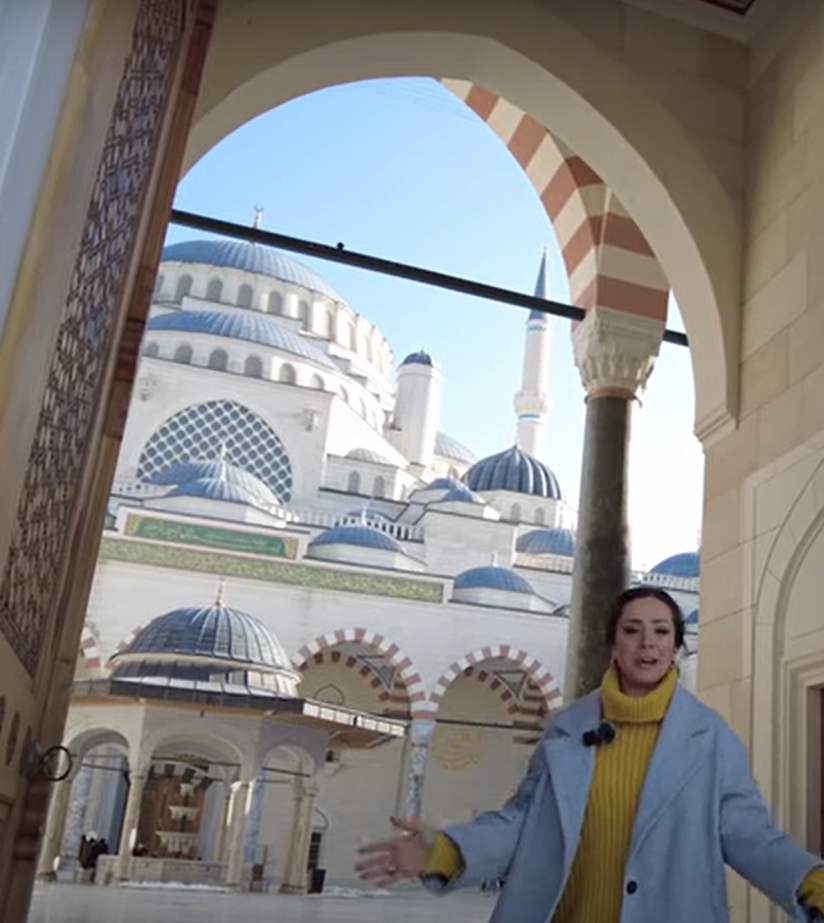
Çamlıca
Mosque (Turkish: Çamlıca Camii) is a mosque located in Istanbul and the largest
mosque in Turkey. The mosque can hold 63,000 people and includes a museum, art
gallery, library, conference hall, and underground parking lot for 3,500
vehicles.
Çamlıca Mosque was designed by two female architects, Bahar Mızrak and Hayriye
Gül Totu, at a cost of around TL 150 million ($66.5 million). The length of the
four mosque minarets span 107.1 metres, a measurement that refers to the Battle
of Manzikert (1071) fought by the Seljuk and Byzantine Empires.
The mosque is one of a number of megaprojects built by the Turkish government
to show the strength of the economy and provide a legacy for the governing AK
Party. Turkish President Erdoğan said at its inauguration: “When a horse
dies it leaves behind its saddle, when a man dies he leaves behind his works.
We will be remembered for this.” Turkish analyst Ziya Meral told The Times
that “This is about cultural diplomacy and a vision of Turkey’s role in
the world.”
The Çamlıca Mosque was inaugurated on 4 May 2019 by Turkish President Erdoğan.
Several world leaders were present at the ceremony including Senegalese
President Macky Sall, Guinean President Alpha Conde, Albanian president Ilir
Meta, Palestinian Prime Minister Mohammad Shtayyeh and other foreign
dignitaries.
Istanbul’s
planned Çamlıca Mosque will be a “female-friendly mosque,” according
to its two female architects, Bahar Mızrak and Hayriye Gül Totu, who have a
budget of around 150 million Turkish Liras for the project.The new mosque,
which will be the largest in the history of the Turkish Republic, will use
“positive discrimination for women,” said Metin Külünk, the construction
engineer and president of the mosque’s foundation.“There will be a separate
place for women to perform ablutions and an elevator to take them to where they
can pray. Women will also be able to use a convenient childcare room,” Külünk
told Anadolu Agency.
Intended
for a 3 hectare area in the Üsküdar district of Istanbul, the Çamlıca Mosque
will also include a special area for the disabled, a platform from where
visitors can observe prayers, an Islamic art gallery and museum, a library and
a car park for 3,500 vehicles. A tunnel will also be constructed between the
mosque and the nearest residential area to allow more people to reach it and
avoid traffic congestion, according to daily Cumhuriyet. The
three-kilometer-long tunnel will connect Çamlıca Hill and Libadiye Crossing,
and was discussed in a recent Istanbul Greater Municipality meeting.
The
municipality council’s members from the main opposition Republican People’s
Party (CHP) refused to discuss the tunnel proposal, while the ruling Justice
and Development Party (AKP) members voted “yes.” The project will soon be voted
on by the municipality. Yunus Can, a municipality council member from the
CHP, told daily Cumhuriyet that congestion will be inevitable at the entrances
of the tunnel and it will not be prudent spending for the common good.
The
controversial mosque, which is seen as one of President Recep Tayyip Erdoğan’s
signature projects, has been widely criticized for its location atop the green
Çamlıca Hill and for being an incredibly large project that does not appear to
fill a need for locals in the area. The project managers have said they want
the mosque to be seen from most parts of the city and also say it will have the
highest minaret.Meanwhile, in Denmark, a female-friendly mosque is also planned
to be built in the country’s second-largest city, Aarhus. Construction will
begin in 2016 if the local municipality agrees on “a decent location for the
mosque,” said the project’s Turkish architect, Metin Aydın.
He
said the mosque’s design was a combination of Ottoman Islamic architecture and
the local traditions of Denmark and Scandinavia. Facilities at the mosque
will include a separate prayer space for 600 women in the central hall and
services such as a car park and playground for children that will “create the
possibility for more women to go to the mosque.” Recognizing that traditionally
more men visited mosques than women, Aydın said “we want to change this;
we want women to be equal in terms of having the possibility of going to
mosques.”
Planning
began in 2000 and since then all locations put forward for the 3,000
square-meter space have been turned down by the Aarhus Municipality, said
Aydın, claiming that the only obstacle they faced was
“political.” “The mosque in Aarhus will belong to all Muslim men
and women, because the community here includes people of very different
origins: Turkish, Danish, African, Middle Eastern, Kurdish and people from the
Balkans.” The building will cost approximately 6 million euros.
References
http://www.arkitera.com/proje/1396/3-mansiyon-istanbul-camlica-camii-mimari-proje-yarismasi-
https://en.wikipedia.org/wiki/Çamlıca_Mosque
http://www.hurriyetdailynews.com/istanbuls-giant-mosque-to-be-women-friendly-architects-say-74329
https://www.dunyabulteni.net/yurt-haberleri/camlica-camiinin-projesi-belli-oldu-foto-h235170.html
I agree to the terms outlined below:
You agree to upload and assign Mosqpedia Database the rights to use the content worldwide and in perpetuity across all current and future media platforms. Mosqpedia Database may edit, copy, adapt and translate your contribution.
The content will be distributed under the Creative Commons Attribution-Deed – Attribution-NonCommercial-NoDerivatives 4.0 International – Creative Commons
All data will be stored in line with data protection regulations.
I agree to the terms outlined below:
You agree to upload and assign Mosqpedia Database the rights to use the content worldwide and in perpetuity across all current and future media platforms. Mosqpedia Database may edit, copy, adapt and translate your contribution.
The content will be distributed under the Creative Commons Attribution-Deed – Attribution-NonCommercial-NoDerivatives 4.0 International – Creative Commons
All data will be stored in line with data protection regulations.